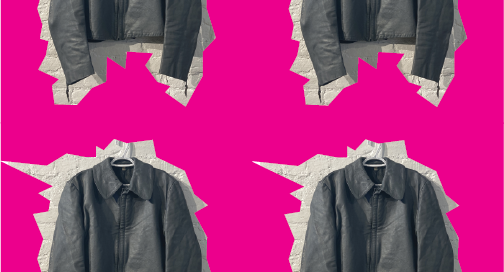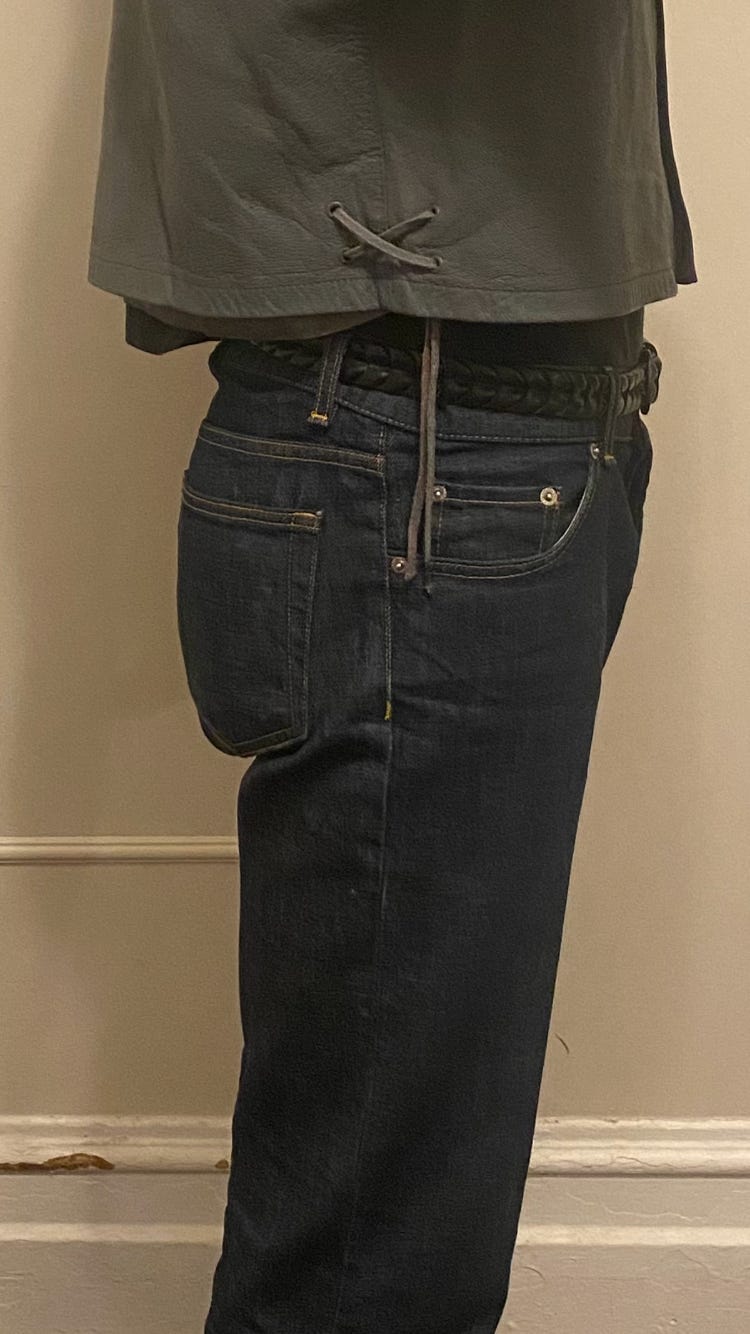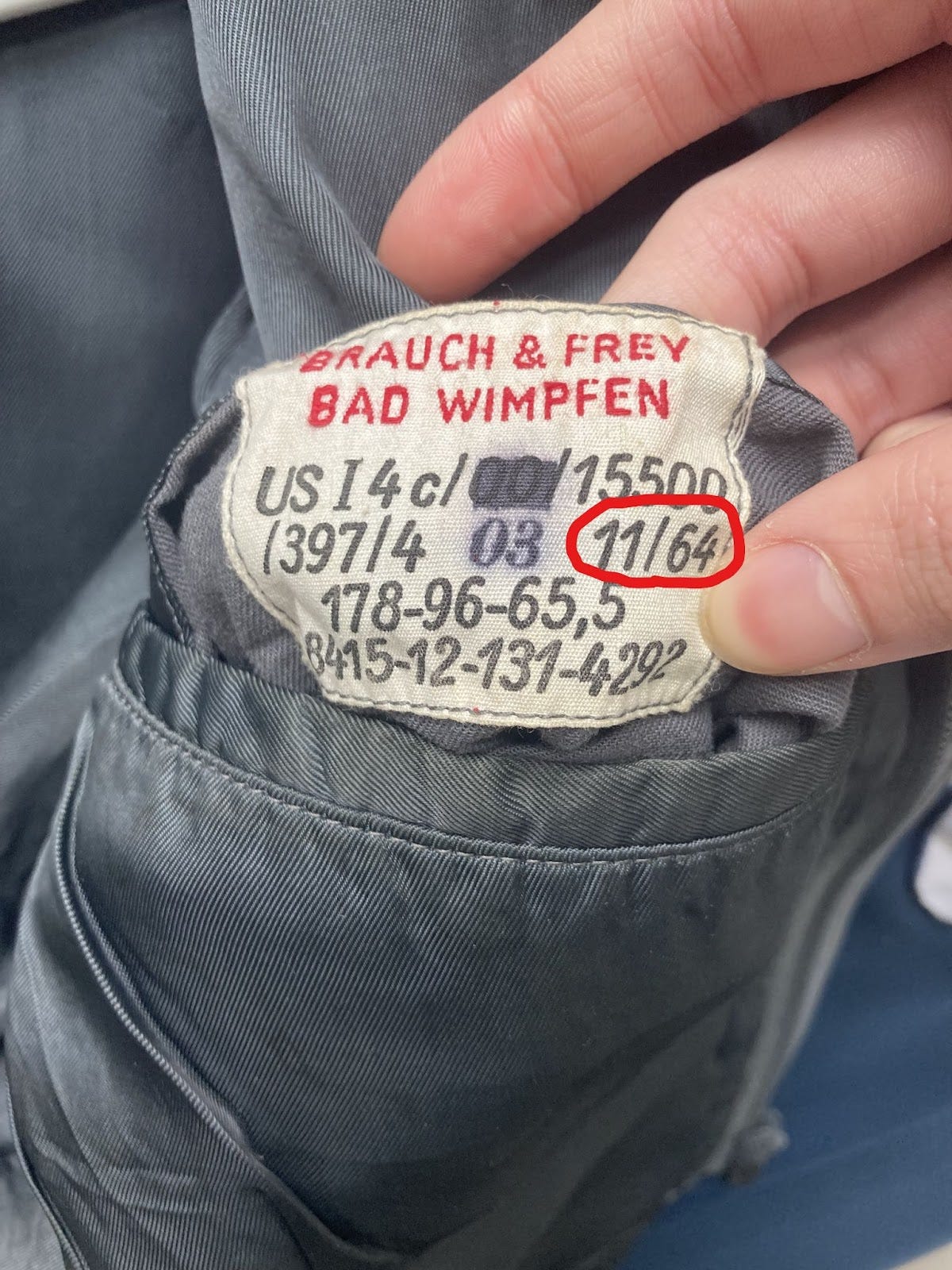My fascination with this jacket began in October 2021. I was on Instagram, looking at a clothes seller page called @guerrero.sto. I wasn’t searching for anything in particular, just typical idle brain-rot browsing. A grey jacket catches my eye. Every detail looks slightly different than usual: the curved sleeves, the rounded instead of pointed collar, the wrist zips, the strings hanging off the sides. And best of all, it’s cropped.
I despise long shirts and jackets that don’t commit to their length. There is appeal in a trench coat, but that bleh in-between length never does the wearer any favors. The legs appear shorter and the torso becomes longer and wider. You look like a traffic cone on stilts.
A jacket that stops at the waist creates a sharp transition between the torso and legs, visually splitting an outfit at the belt. The legs look longer because the pants are fully visible. Nothing is being covered by loose fabric, making the look smart and streamlined.
Grey leather with a large rounded collar. It’s hard-wearing, contemporary, unique, and it has some history behind it. In other words, I had to have it.
You know when you find a piece of clothing with a bunch of one-off details that all happen to match up with your one-off tastes in a garment? Seeing it for the first time comes with a moment of realization that if you let it pass you by, you might never find another one. So I click on the post and read the description. “SOLD”.
I entered the Google Images rabbit hole in search of the Sub jacket. I look up “Grey German submarine jacket” and WW2 models come up, I’m looking for 1960s and later. I scroll down a bit and find the correct model. Sold out on the site the image links to, but there are other listings in the related images.
After more unsuccessful attempts, I click an Etsy link. Brings me to the jacket at a price of 120 USD. I am trying to exercise discipline, so I tell myself “I don’t need this now, I can find one later for a better price.” I regretted this decision for a few days then gave up my pursuit of the jacket for close to a month.
I should have trusted myself earlier, because I ended up being right. After an uninterrupted, 3-hour-long session of searching, I found the jacket in stock for a reasonable price. A German military surplus site was selling the jacket for 30 euros plus taxes and shipping to the US. Bought one, the arms were too short for me, bought another.
Out of stock now, sadly
The jacket was produced for German submarine crews, which explains the cropped body. Submarine operators are often sitting down, and the jacket’s short length stops right at the waist, giving the uniform an air of distinction even when seated. Of course, the design choice isn’t all for show. The lack of excess material lets the operator move freely and prevents them from getting caught on a seat.
There are some differences between the two jackets I have. The smaller one is a less grainy, lighter-colored leather and is distinctly heavier. The second is thinner and the collar is slightly larger. Brauch & Frey Bad Wimpfen manufactured the small jacket and the larger one was made by Modeka.
Other differences of note: The B&F jacket holds its shape better on the hanger because of the heavier leather, the B&F jacket also has a boxier shape with the sleeves higher on the torso, both jackets were designed with curved sleeves for better arm mobility
Multiple sources date the jacket’s production run to the 60s-90s and say it was produced for German submarine crews, however, there is a minor issue. I can’t find an image of a German soldier wearing it, or any official documents confirming its origin. So, I decided to piece together the Sub jacket’s history by researching the companies that made it.
All of the jackets have tags on the inside of the left-hand pocket that state their manufacturer, these were leather companies in Germany contracted by the Bundeswehr to produce the jacket. Modeka and Brauch & Frey were not alone, there were multiple other manufacturers that were involved in production over the jacket’s lifespan. I’ve found 5 different companies, but there are likely more out there.
The three manufacturers I will be going over are Beckhumer Lederwerk, Modeka, and Brauch & Frey Bad Wimpfen. Out of the 3, Modeka is the only one still in business. They make leather jackets for motorcyclists and their operations are still mostly confined to Germany. Their LinkedIn page says they’ve been around since 1947, putting them within the range of the Sub jacket.
In addition to stating the manufacturer, the tags on the inside of each jacket include a set of cryptic, unlabeled numbers.
I searched for guides to reading these tags and found nothing of use. When researching Brauch & Frey, I may have stumbled upon the answer. I found an image of a flight suit dated to 1962, and its tag has the same layout as the Sub jackets. If the transitive property can be trusted, the Brauch & Frey jacket I have is from 1964 and the Modeka jacket is from 1988, which makes sense considering the difference in leather quality.
As a general principle, later-produced iterations of the same item tend to be lower quality than earlier outputs. When something has staying power, it almost always has sustained or increasing demand, which commonly leads to mass production, which commonly leads to skimping on materials in order to cut costs.
Date circled, produced November 1964
After looking into Modeka, I turned to Beckhumer. I searched their name and found a decrepit Facebook page with little more than the company name. The name of the page was Beckumer Leder, no “Werk”. Interesting. I drop the Werk and search Google again. The first result? Modeka Center in Hamelin, Germany.
As it turns out, Modeka has two flagship stores: one in Hamelin and one in Beckum. So, Beckhumer Lederwerk was likely a subsidiary of Modeka or another name they went by in the past. The pieces are starting to come together.
On to Brauch & Frey Bad Wimpfen, the creator of my smaller jacket. They were active from the 1940s to the 1960s, however, most of their jackets listed online are from the 60s. As a town of 7,000 people, Bad Wimpfen was a peculiar location for a military-contracted leather manufacturer.
B&F’s lack of post-60s production suggests that they were unable to fulfill increasing Bundeswehr order demand, or that they were unable to lower their pricing sufficiently to remain competitive with larger operations. A quick explanation of government contracts to lend context to the previous sentence: Whoever is willing, or able, to offer the lowest price for their service while meeting a certain quality standard will “win” a government contract.
The Sub jacket’s biological parents are the short cotton officer’s jacket and the 1940s U-boat leather jacket. The U-boat leather jacket is the same color leather as the Sub jacket, a design choice likely intended to camouflage the wearer when on top of a surfaced submarine.
U-boat jacket worn by the captain of the submarine, identified by his white cap
The origin of the short cotton jacket’s use by German submarine crews is worth mentioning. Up until the mid-1930s, a mid-hip length coat was standard battle dress for most countries. During World War 2, some countries started to adopt shorter jackets for their increased mobility, Britain was one of them.
Following the battle of Dunkirk and the subsequent evacuation of British soldiers, the German army seized a large amount of British uniforms, reappropriating them for their own use. They adorned them with Nazi imagery and they became a common sight on submarine crews. The Germans liked the design of the uniform so much that they would later create their own version, which was likely the direct predecessor to the cropped leather Sub jacket.
A reappropriated British uniform with Nazi insignia over the left pocket
The best designs do not emerge out of thin air, they are a logical progression from past items. Two or more past models are packaged into one, making something new enough to feel innovative, but not so new that the transition is jarring to the wearer. This slow-growth process of innovating through evolution works best in the incubated environment that most military garments are developed in.
There are two key differences in the military market that allow for the effective development of a garment: increased structure and little incentive for over-innovation.
The freedom of the consumer market is a blessing for the amount of options available to customers, but a hindrance to perfection in any one option. Competition is waged on the dimension of difference because brands have little incentive to compete with extremely similar products. In such a scenario, brands would merely be cannibalizing each other and pouring resources into a venture with limited financial reward.
Slow-growth processes may occur within a single brand’s organization, but they will rarely involve interplay across multiple brands. Yes, brands will sometimes opt to ride the coattails of a trend, but that proposition is hardly associated with pushing the envelope for a style, it’s moreso “Make a mediocre version of X item and take it to market quickly to siphon some profit”. Chasing trends is, by its nature, a rushed process that cannot incorporate the deliberate effort needed to make meaningful developments in a garment’s core design.
When each manufacturer is adhering to a strict set of guidelines, as in a military environment, slight optimizations become the only means of setting yourself apart. The option to flip the briefing and go in a different direction no longer exists, which forces innovation until a garment has reached its functional limit.
If a garment is built for function, there is no pressure to alter its design once an iteration is created that effectively satisfies the prerequisites. Aside from some unfortunate modifications to materials to reduce costs, the Sub jacket went virtually unchanged for 30 years. Consistency over time is the definition of staying power, and a stable design conveys an assuredness in the product that has an undeniable allure.
Why is this jacket important? Like most military garments, it’s a period piece and a highly situational piece. Every detail, from the enlarged collar to the cropped length, can be traced to a desired function.
The peculiarities that result from tailoring a piece of clothing for a specific application make military garments highly compelling design. You make a jacket for people who sit in a metal pill underwater for months at a time. And the DNA of that metal pill is in every element of your jacket, because it wasn’t meant for civilians to wear. It had no intentions of being marketable, or palatable, or appeasing. That total lack of concern for anything besides “how well will this work for a submarine operator?” makes the Sub jacket a strange, unique, and fascinating garment.
Some of the greatest clothes of our time have emerged from work applications. The white t-shirt, the Levi’s 501 (the perfect pair of jeans), the MA-1 jacket, aviator sunglasses, Doc Martens.
Fashion can be designed to be fashionable, but the best garments are often driven by history and meaning. When you wear a well-fitting white t-shirt, you become part of a past that includes James Dean, soldiers, idyllic suburb dwellers from the 1960s and everybody in-between, before, and after. You identify with the history of a garment, and wearing it is a tongue-in-cheek way to display your affiliations and tastes.
Many timeless designs don’t set out to be fashionable, and that backwards approach is what makes them successful. Meaning behind details can’t be faked, and meaning behind details gives those details staying power. When all is said and done, the pursuit of function gives a garment a spine to stand on after the smoke clears and the trend cycle leaves it in the past.
Please share with a friend or subscribe if you haven’t. Thank you so much for reading, it means a lot.














Good read, really well researched. Also drippy as hell 🥶
Such an enthralling backstory to the iconic jacket